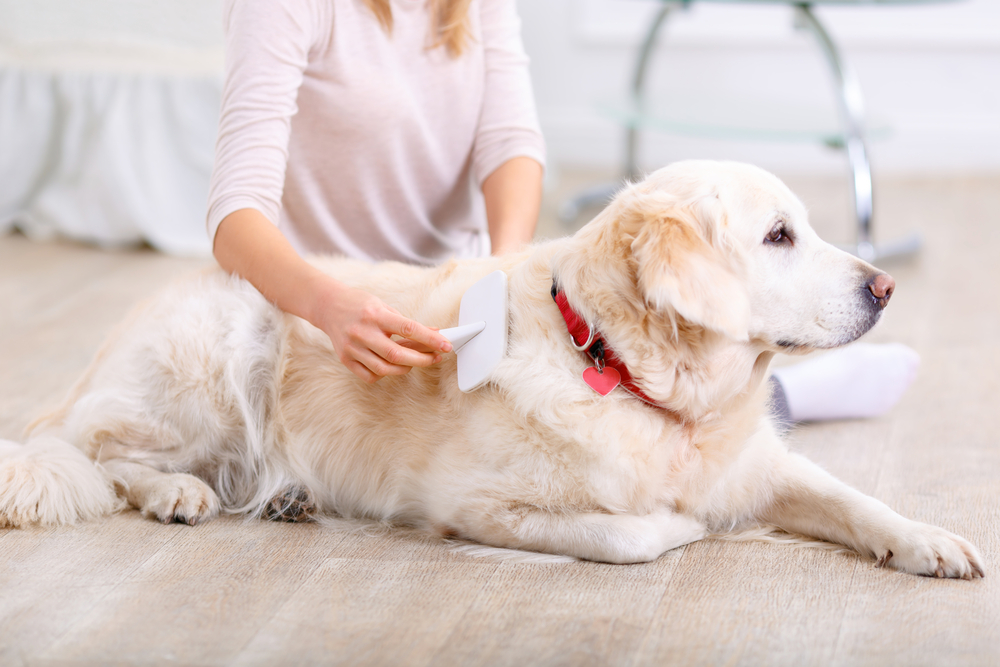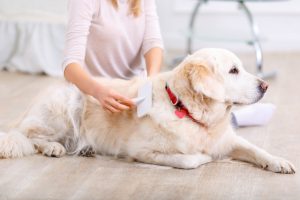There are a few different reasons why you might want to upgrade your grooming routine with some new tips for dog brushing.
The most obvious reason is that your pupper will look stunning while they strut their stuff down the sidewalk. But it’s not just about looking their doggy best. With some insider tricks, you can convince even the most brush-hating doggos to come around to and even enjoy grooming sessions. The result will be healthier skin and fur and maybe even a stronger bond between you and your beautiful pup.
Whether you want to brush your dog yourself or touch up your dog’s looks between professional grooming sessions, these tips will help your dog feel good about brushing!
Tip #1: Get to know your dog’s coat needs
The way that you groom your dog will depend a lot on their specific coat type.
One category that you’ll want to consider is whether your dog has a single layer or a double layer coat. Puppers on the list of top shedding dogs, for instance, tend to have soft, downy undercoats that require more frequent brushing. Short-haired pups, like the Australian Bulldog or Great Dane, on the other hand, don’t need to be brushed more than about once a week. In fact, overbrushing could cause these short-coated pups some irritation.
You’ll also want to home in on what kind of fur your dog has. Curly and long silky coats, for example, need to be combed every day or every few days to prevent tangles and matting. Waiting too long to brush out your furbaby could make each grooming session uncomfortable.
Read up on your dog’s breed to know more about the grooming needs for their unique coat!
Tip #2: Invest in the right grooming gear
If you’ve ever been overwhelmed by the amount of grooming tool options at your local pet shop, don’t worry. You’re not alone! But the good news is, the range of options available means that you can choose a brush that is perfect for your dog’s coat.
Undercoat rakes are ideal for very floofy dogs like Huskies, while a wide-toothed shedding comb will be better for dogs with long, flowy hair like the Borzoi. A soft bristled brush or grooming glove will keep short haired pups comfortable while removing dirt and debris.
And if you’re looking for something that will work for most coat types, stick with a good old fashioned slicker brush, which you can typically find with one soft bristled side and a rounded pin side.
You can learn more about the different kinds of dog brushes in our article, Grooming Tips & Tools!
Tip #3: Get your dog in the right mindset
Anytime that you’re introducing your dog to something potentially uncomfortable, it’s a good idea to spend some time doing mood-boosting activities. Take them for a walk, play a nice tiring game of tug, or allow them to sniff to their heart’s content in the backyard. This will burn off excess energy and put them in the right mindset for some puppy pampering.
Tip #4: Start at your dog’s comfort level
If your dog is completely against being brushed, your first priority will be to get them comfortable with the grooming tools. You can do this by showing your dog the brush and giving them treats and positive praise for sniffing it or being close to it. This may take several short sessions until your dog is ready to be brushed. Even then, stick with a few brushstrokes at a time.
For dogs who are more tolerant of the process, it’s still a good idea to provide them with treats and positive praise as you brush. This will be the key to your dog learning to enjoy and even look forward to their grooming sessions.
Tip #5: Slow down and be gentle
We get it. Grooming is just one of many tasks that you have to put on your Dog Owner to-do list. You might only have a few minutes to spend tackling those tangles!
But, if you can spend those minutes creating a comfortable, calming experience for your doggo, you’ll find that each grooming session is more effective. That could mean spending only a few minutes slowly and gently brushing out the fur around your dog’s neck. At another point in the day, maybe you take a pass at the fur along their back and legs.
Tip #6: Go with the flow (of your dog’s fur, that is)
Pay attention to the direction in which your dog’s fur grows and take care not to brush against the grain.
Of course, if your pupper looks like a floofball with gravity-defying fur, you might not be able to tell which way the fur grows. In that case, start at the top of the head and brush down and towards the tail.
Tip #7: Take special care with sensitive areas
Just like humans, dogs have ticklish areas and parts of their body that are more sensitive. While every dog is different, your furry friend might try to wriggle away when you touch their tail, ribs, ears, or feet.
Instead of holding your doggo down while you brush out these areas, spend very short amounts of time and offer your dog extra rewards for their patience. Your pupper may never be fully comfortable being brushed everywhere, but they can become more tolerant with patience and incentives!
Tip #8: To really pamper your pup, call in the pros
Even with all of the tips for dog brushing that you might try to implement, at the end of the day, your pupper may be better off in the hands of a professional! By calling in a dog-lover with expertise, your furry friend will enjoy a full spa day with their favourite local dog groomer.
They’ll come back to you washed, brushed, and feeling great so that you can focus on other bonding activities like enjoying a nice snooze on the lounge!
Will you try these tips for dog brushing?
If your pup gives the grooming supplies the side eye, you might find that these simple tips put you on a path towards better brushing! Not only will their coat look clean and healthy, but with patience and treats, grooming sessions can become an enjoyable bonding experience for you both.
We’d love to hear your dog grooming challenges and your own tried-and-true tips for dog brushing!


